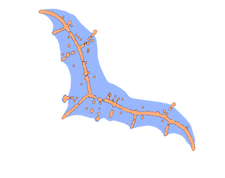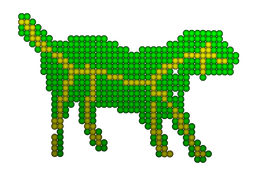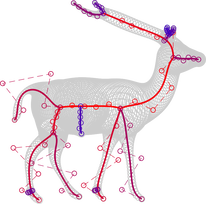We release our dataset in different formats to run a competition with our workshop. We provide shape datasets with corresponding skeleton representations in three domains, as well as some complementary sources (pre/post processing, sampling, and data augmentation scripts). The challenge will be posed as extracting the skeleton from a given shape, as detailed below. More information can be found in our paper.
The participants will also be required to submit a short paper (4 pages maximum) detailing their methodology, which can later be extended as a full paper for further publication. The top submissions in each category will be chosen as finalists and will be invited to present their research in the oral and poster sessions of the workshop. The winners in each track will receive a Titan RTX GPU, sponsored by NVIDIA.
The participants will also be required to submit a short paper (4 pages maximum) detailing their methodology, which can later be extended as a full paper for further publication. The top submissions in each category will be chosen as finalists and will be invited to present their research in the oral and poster sessions of the workshop. The winners in each track will receive a Titan RTX GPU, sponsored by NVIDIA.
Timeline
Feb 20, 2019 |
Call for challenge |
Feb 20, 2019 |
Paper and challenge submissions open |
April 3, 2019 April 6, 2019 |
Paper and challenge submissions close |
April 14, 2019 |
Notification to authors |
April 19, 2019 |
Camera-ready paper |
June 17, 2019 |
Workshop on Deep Learning for Geometric Shape Understanding |
Shape Pixels to Skeleton Pixels
|
As the most common data format for segmentation or pixel-wise classification neural network models, our first domain poses the challenge of extracting the skeleton pixels from a given shape in an image. The participants need to overcome fundamental problems like class imbalance, global structure search, and robustness constraints while reducing the given shapes to clean skeleton pixels. Although the output will not be a true geometric representation, it is easier to convert the skeleton pixels to a vector format. We expect the challengers to provide results in terms of the accuracy better than the current best skeleton extraction from images in the system. This will be a binary classification problem to detect the skeleton pixels for a given shape image.
|
Shape Points to Skeleton Points
|
The second challenge track investigates the problem in the point domain, where the shapes will be represented by point clouds as well as the skeletons. This track also emphasizes some fundamental questions as how to process non-uniform data, how to overcome class imbalance, and some exploration in higher dimensional point clouds. We expect the challengers to provide results in terms of the accuracy better than the current best skeleton extraction from points in the system. This can be posed as a binary classification problem to assign a skeleton/non-skeleton class to all points in the given point cloud; however other formulations (i.e., as in transformer networks) are also accepted to solve this challenge.
|
Parametric Skeletons
|
The last domain aims to push the boundaries to find true parametric representations of the skeleton of the shape, given its image. The participants are expected to output the skeleton of the shape defined by its parametric curves, together with a radius function. The main challenge of this track arises from the domain change between the input and output, so representation of the output in a deterministic way is the key motivation of this track. We expect the challengers to provide results in terms of the accuracy better than the current best parametrized skeleton. This will be a recognition problem (similar to the problem of pose estimation) to detect the geometric representation (Bezier curves) for a given shape image.
|


